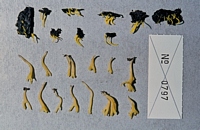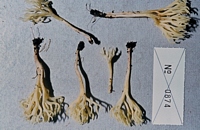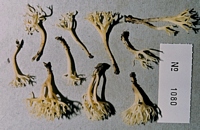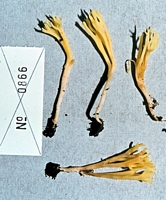|
 Ramariopsis junquillea Ramariopsis junquillea
BiostatusPresent in region - Indigenous. Endemic
Images (click to enlarge)
Caption: [JAC: mixed collection?] 1523, id. R. Petersen, label 50x10mm,
Owner: E. Horak | 
Caption: [not the same taxon as 1523?] 1527 (x 874), id. R. Petersen, label 50x10mm, NZ, NI, Urewera N.P., on soil under Nothofagus sp., 02.06.1981, leg. EH
Owner: E. Horak | 
Caption: 1080, id. R. Petersen, label 50x10mm, NZ, NI, Waitakere R., Kauri Glen, on soil under Leptospermum,
Phyllocladus, agathis, 07.07.1981, leg. EH
Owner: E. Horak | 
Caption: 1520 (x 866), id. R. Petersen, label 50x10mm, NZ, NI, Urewera N.P., on soil under Nothofagus sp., 31.05.1981, leg. EH
Owner: E. Horak | |
Article: Petersen, R.H. (1988). The clavarioid fungi of New Zealand. New Zealand Department of Scientific and Industrial Research, Bulletin 236: 170 pp. Wellington:.
Description: Fruit bodies up to 2.3 x 2 cm, repeatedly dichotomously branched, individual to cespitose or connate in small groups, lacking a basal patch or pad, apparently inserted nakedly. Stipe discrete to almost absent, "cream color" to bright clear golden yellow ("capucine-buff", "light ochraceous buff") to pale yellow ("cream-buff", "chamois"). Branches in 2-4 ranks, up to 3 mm thick, terete to flattened, clear yellow ('baryta-yellow", "cartridge-buff", "buff-yellow", "Naples-yellow", "maize-yellow", "apricot-yellow"); axils rounded, internodes diminishing gradually. Apices awl-shaped; short to long, often divergent, occasionally bluntly rounded, pale clear yellow ("pale orange-yellow"). Taste none to mildly bitter; odour negligible to penetrating, menthol-like.
Macrochemical reaction: FCL = weak olive-green, or avellaneous grey.
Tramal hyphae of branches hardly inflated, thin-walled to somewhat thick-walled (wall up to 0.3 gm thick), hyaline, conspicuously clamped, parallel, free, often sinuous, weakly to strongly dextrinoid. Subhymenium at first hyphal, then pseudo-parenchymatous. Hymenium thickening significantly, old basidia persistent but crushed; basidia 28-33 x 6 gym, subcylindrical, hyaline, clamped; sterigmata 4, straight, slender, divergent. Sclerified basidia or cystidia (Fig. 119) 25-31 x 6-7 gm, clavate, distally rounded or with suggestions of sterigmata, highly refringent under phase contrast, apparently extremely thick-walled, the wall often filling the lumen.
Spores 4.3-4.7 x 2.9-3.6 gm (E =1.20-1.44; E- = 1.31; L- = 4.43 gm), ellipsoid to ellipsoid-ovate, thin-walled, smooth, weakly dextrinoid; contents opalescent to multiguttulate; hilar appendix papillate, small.
Notes: I can see no spore ornamentation at x2250 in bright field or phase contrast.The small hilar appendix would lead the casual observer to conclude that the taxon was a member of Clavaria subg. Clavulinopsis, but the positive FCL reaction leads to Ramariopsis. Furthermore, other taxa in Ramariopsis produce weakly dextrinoid spores. The cystidial structures are confusing, for they resemble sclerotic basidia, such as those found occasionally in Ramariopsis fusiformis (Sow.: Fr.) Pet., and R. corniculata (Pers.: Fr.) Pet. (Petersen 1971). They may be found only in thickened hymenia, however, and then in a single layer arising from the very inner subhymenium next to the tramal hyphae. Some are seen to be refringent, but here and there the thick wall is obvious. Were they gloeoplerous, then together with narrow tramal hyphae and positive IKI reaction with spores, one might be led to conjecture on some relationship with Clavicorona. I do not think this is so. TENN no. 42413 shows no sclerotic basidia, but the hymenium was also not significantly thickened. If sclerotic basidia are formed late, but deep in the subhymenium, juvenile specimens may be without them.
Most specimens have dried with pale opaque stipes and ruddy orange cartilaginous branches. They may be characteristic of the taxon.
|